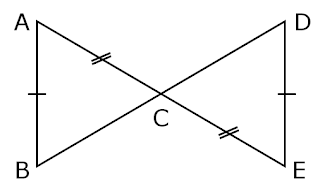Congruent triangles Worksheet with Solution
Congruent triangles Worksheet
Problems and Solutions
Example : (1) In figure if AD = CD and AB = CB.
(i) Find the three pairs of equal parts in △ABD and
△CBD.
(ii) Is △ABD ≅ CBD ? Why or why not?
(iii) Does BD bisect ∠ABC? give reason.
Solution : (i) In △ABD and △CBD, three pairs of equal parts are, Sides of triangles.
AD = CD (given)
AB = CB (given)
and BD = BD (Common in both triangles)
(ii) △ ABD ≅ △ CBD
From solution (i), by (SSS congruence rule)
(iii) BD bisect ∠ABC, because
∠ABD = ∠CBD (Corresponding parts of congruent triangles)
Example : (2) Check whether two triangles are congruent or not.
Solution : In figure △ ABD and △ PQR are right angled triangles.
In △ ABC and △ PQR,
∠ABC = ∠PQR (Both are right angles)
side BC = QR (Given)
Hypotenuse AC = PR (Given)
Hence, △ ABC ≅ △ PQR (RHS congruence rule)
If the hypotenuse and one side of a right angled triangle are respectively, equal to the hypotenuse and one side of another right angled triangle, then the triangles are congruent.
Example : (3) Check whether two triangles are congruent or not.
Solution : In figure △ ABD and △ PQR are right angled triangles.
In △ ABC and △ PQR,
∠ABC = ∠PQR (Both are right angles)
side BC = QR = 4 cm (Given)
Hypotenuse AC = PR = 5 cm (Given)
Hence, △ ABC ≅ △ PQR (RHS congruence rule)
If the hypotenuse and one side of a right angled triangle are respectively equal, to the hypotenuse and one side of another right angled triangle, then the triangles are congruent.
Example : (4) Which congruence criterion do you use in the following.
Given AB = PQ
BC = QR
and AC = PR
Solution : In figure △ ABC and △ PQR, given that
AB = PQ
BC = QR
and AC = PR
In △ABC and △PQR, three pairs of equal parts are, sides of triangles.
Hence, △ ABC ≅ △ PQR (SSS congruence rule
Example : (5) Check whether two triangles are congruent or not.
Solution : In figure △ ABC and △ PQR, given that
AB = PQ (From the figure)
BC = QR (From the figure)
Given information for the congruence of two triangles, in the figure is not sufficient.
We can not conclude, whether the two △ ABC and △ PQR are congruent or not.
Example : (6) Check whether two triangles ABD and CDB are congruent or not.
Solution : Two triangles, △ ABD and △ CDB, are given.
In △ ABD and △ CDB,
AB = DC (From figure)
BD = BD (Common in both triangles) ∠ABD = ∠CDB (From figure)
Hence, △ ABD ≅ △ CDB (SRS congruence rule)
Example : (7) Check whether two triangles ABC and DEC are congruent or not.
Solution : In the figure two triangles are △ ABC and △ DEC, and given that, AB = DE (From figure) AC = CE (From figure)
∠ACB = ∠DCE (Vertically opposite angles)
From above three congruent parts of triangles, we get ASS congruence, but ASS congruence does not work for congruent triangles.
Hence, △ ABC and △ DEC are not congruent.
Example : (8) Check whether two triangles AMP and AMQ are congruent or not.
Solution : In the figure two triangles are △ APM and △ AQM, and given that,
PM = QM (From figure)
AM = AM (Common in both )
∠AMP = ∠AMQ (Given)
Hence, △ AMP ≅ △ AMQ (SAS congruence rule)







